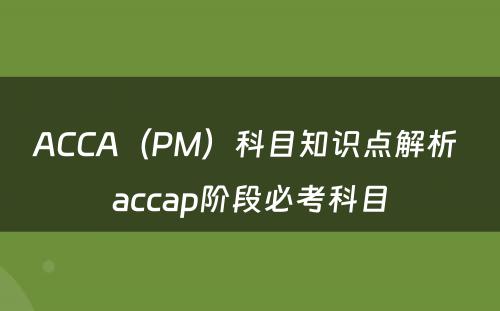ACCA(PM)科目知识点解析 accap阶段必考科目

ACCA(PM)科目知识点解析

2023年ACCA备考工作已经陆陆续续开展,在ACCA考试中,PM科目“角色定位”“限制因素”一直都是常考点,对此,小编今天就跟大家着重详解这个考点内容。
关于PM中的角色定位
其实很多概念误区都是一开始没有找准定位导致的,然而这个问题却一直被你们忽视!如你们最喜欢的:
Transfer pricing
角色1 Standing from the perspective of the whole corporation: Total profit maximization is the most important,so internal transfer is always preferred than sourcing products from outside.
角色2 Standing from the perspective of the individual divisions: Divisional performance is the most important, so an evaluation between sourcing/selling outside and internal transfer should be made.
正是因为角色不同,而如果企业又赋予了部门“能够站在自己的角色上考虑问题”的权力(autonomy / company policy is not always the case),才会有transfer pricing中的“定价”一说;
那么站在部门角度上考虑自个儿利益优先的问题,自然会将cost of sourcing/selling outside(A)和cost of internal transfer(即transfer price B)做对比,故而我们绝大时候遇到的场景都是,已知A,求解B,so if internal transfer should be selected...
购货方Sourcing outside(market price) = A: B
供货方Selling outside(market price) = A: B=A
因此延伸出概念:Market-based price exactly should be considered as an ideal price for transfer pricing.
因此延伸出概念:Pricing can be determined via 3Cs:
Competitors(Market-based pricing)
Cost(Cost-based pricing)
Customers (Market-based pricing)
因此延伸出概念:If market-based not feasible -- cost based pricing should be considered.
因此延伸出概念:When market-based not feasible?
Others
诸如此类的问题有很多,如果能够学会找准定位,切换不同定位思考问题,很多原理性的概念就顺理成章了;PM概念题多考此类型的理解,如业绩评估中:
角色1:经理 -- 关注本部门,关注可控因素,controllable factors
角色2: 企业 -- 关注所有部门和影响企业的因素,controllable + uncontrollable factors
关于PM中的限制因素
稀缺资源的配置问题是管理层(management)决策场景中最常遇到的问题之一,故而成为了PM的重要话题(毕竟整个PM都要求站在management的角度上考虑问题),而识别(identification)稀缺资源,解决配置(resource allocation)问题就是其中最关键的两个环节,此部分常见的概念考察,也是从这两步延伸而来的,打蛇打七寸,掌握这两步,你还要啥自行车。
A. Identification
既然是“稀缺资源的配置问题”,那么首先就要找到稀缺资源是什么!(first step)
因此延伸出概念:稀缺资源(scarce resource)是什么;何谓稀缺 - 稀缺是指相对于人们无限多样、不断上升的需求来说,用以满足这些需求的多寡,即有用的资源总是相对不足的。
因此延伸出概念:了解产品的最高市场需求(first step in first step)-了解用于该产品的有用资源-了解单位产品对不同资源的消耗量-找到稀缺资源=可用资源总量
因此延伸出概念:Throughput accounting: A bottleneck 该稀缺资源只有一个;Limiting factor analysis: Limiting factor(s)该稀缺资源有一个或多个
因此延伸出概念:若无直接题意提示(如出现throughput等相关字眼),默认选用Limiting factor来做稀缺资源的配置问题,毕竟考虑更周全
因此延伸出概念:什么时候更容易出现多种稀缺资源 --- 考虑问题更长远的时候
Throughput accounting (throughput accounting): short-term profit maximization
Limiting factor analysis (marginal costing): longer-term view of resource management
B. Resource allocation
找到稀缺资源,开始配置-何为配置-即多种产品ABCD均争抢该资源X,而分配权在你这个管理层(management)手上。
因此延伸出概念:管理层需要找到能让ABCD对其分配方案心服口服的方法,必然要引入公平竞争模式,竞争就有输赢,就需要衡量标准(管理层口号:为股东财富最大化努力),故而他们关注极致性价比:
Throughput accounting:
cost=Factory cost per Bottleneck;
benefit=Throughput per Bottleneck;
Cost benefit analysis=TPAR=Throughput per Bottleneck/Factory cost per Bottleneck
Limiting factor:
cost=variable cost per Limiting factor
benefit=selling price per Limiting factor
Cost benefit analysis=Contribution per Limiting factor
因此延伸出概念:根据计算不同产品的上述标准大小,进行排序;排名靠前,优先获取能满足其最大市场需求的资源的分配权,根据排名,先到先得~
因此延伸出概念:必有产品因为企业资源有限,或是排名不行,而被抛弃;但如果该产品对企业来说有着重大意义(如合同规定;如虽比不过其他已达到市场饱和的产品性价比,但也还是有利可图的商品),必须生产,那可如何是好 --- 只能开启寻找‘生命源泉’的漫漫长路。
因此延伸出概念:shadow price阴影价格 - 为这“稀缺的生命源泉”,你愿意“赴汤蹈火”的程度,还是那句话,你是一个理性的manager,你做任何事情,都追求极致性价比,故而碰到生命源泉,你依旧保持冷静的头脑:
Cost=shadow price=extra payment for the bottleneck resource; Benefit=additional contribution per bottleneck.
So when would you like to make the deal (即这次‘探索’是值得的):Cost因此延伸出概念:例:当additional contribution per bottleneck = $100,Shadow price可以是大于0,小于100的任何数据。
除标明原创以外的内容,其他源于网络,请以官方为准。如有侵权:yimgjqzd@qq.com 或者【 点击提交 】第一时间进行删除!






